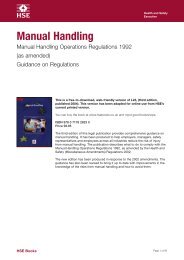Making Companies Safe - what works? (CCA ... - Unite the Union
Making Companies Safe - what works? (CCA ... - Unite the Union
Making Companies Safe - what works? (CCA ... - Unite the Union
Create successful ePaper yourself
Turn your PDF publications into a flip-book with our unique Google optimized e-Paper software.
Chapter Six<br />
The Implications for <strong>the</strong> HSC<br />
Levels of Inspection and Investigation<br />
The research reviewed above demonstrates that <strong>the</strong> prospect of enforcement action is a key<br />
driver for large and high risk operators, as well as smaller firms. 1 However, survey data from<br />
<strong>the</strong> UK suggests that <strong>the</strong> perceived levels of inspection and investigation are currently too low<br />
to provide optimal – or even adequate – levels of deterrence. 2<br />
This perception would appear to be well-founded, since only 1 in 20 premises nationally<br />
received at least one inspection during 2000/2001, though this ranged from 1 in 10 in<br />
construction to 1 in 36 in <strong>the</strong> service sector. In <strong>the</strong> same year 80% of major injuries were not<br />
subject to investigation including for example, <strong>the</strong> amputations of 3 arms, 7 hands, 2 legs, 1<br />
ear and 400 fingers; 210 burns to eyes, 14 burns to <strong>the</strong> arm and 8 burns to faces; and 40%<br />
of <strong>the</strong> 3,214 injuries resulting from ei<strong>the</strong>r ‘contact with electricity’, ‘contact with moving<br />
machinery’, ‘high falls’or ‘drowning/asphyxiations’. 3<br />
These worryingly low levels of inspection and investigation are <strong>the</strong> cumulative result of years<br />
of budget cuts and “financial restraints of increasing severity” imposed by successive<br />
Conservative Governments which, according to <strong>the</strong> former HSE director-general John<br />
Rimington, “no amount of cost-saving and ‘business re-engineering’ could match”. 4<br />
Following <strong>the</strong> election of a Labour government, <strong>the</strong> HSE’s administration budget was<br />
temporarily increased in real terms between 2000/01 and 2001/02. This allowed <strong>the</strong> HSE to<br />
recruit new inspectors, resulting in an increase in inspector numbers of over 25%. 5 However,<br />
in November 2002 <strong>the</strong> HSE budget was effectively ‘re-frozen’, and HSE staff were told that<br />
not only would <strong>the</strong>re be no new recruitment but that vacancies would not be filled. According<br />
to <strong>the</strong> trade union PROSPECT, this will result in a fall in inspector numbers to below <strong>the</strong> level<br />
prior to <strong>the</strong> recent recruitment. 6<br />
According to respondents in many of <strong>the</strong> UK studies <strong>the</strong> best way of securing higher levels of<br />
compliance would be to increase inspections and investigations and enforcement activity. This<br />
would require a considerable increase in <strong>the</strong> level of resources put into front-line inspectors,<br />
but a budget freeze on HSE recruitment means that inspector numbers are, in fact, likely to<br />
decline over <strong>the</strong> next few years. 7 The situation has been exacerbated by <strong>the</strong> Government’s<br />
announcement in July 2004 to cut civil servants within <strong>the</strong> Department of Work and Pensions<br />
(which includes <strong>the</strong> Health and <strong>Safe</strong>ty Commission/Executive. 8<br />
The relative amounts of time inspectors are involved in pro-active inspections on <strong>the</strong> one hand<br />
and re-active investigations on <strong>the</strong> o<strong>the</strong>r has been a long standing pre-occupation of <strong>the</strong> HSE.<br />
In 1997/8 <strong>the</strong> HSE says that <strong>the</strong> balance was 70:30 in favour of inspections. 9 As a result of<br />
<strong>the</strong> recommendations of a Select Committee report in 2000 which criticized <strong>the</strong> low level<br />
of investigations, 10 <strong>the</strong> level of inspection decreased to allow for an increase in <strong>the</strong> level of<br />
investigation so that in 2002/3 <strong>the</strong> balance was 50:50. However “this was not felt to be <strong>the</strong><br />
best balance” and as a result <strong>the</strong> HSE in 2003 – before <strong>the</strong> new Strategy, ‘2010 and beyond’<br />
was announced – decided to change <strong>the</strong> balance between <strong>the</strong> two to 60:40 in favour of<br />
inspections.<br />
The effect of <strong>the</strong> new HSC strategy will almost certainly mean that <strong>the</strong> total time spent by<br />
inspectors on inspections and investigations will be less, so that even if <strong>the</strong> proportionate<br />
level of time spent on inspections - vis-à-vis investigations - will increase <strong>the</strong> total number of<br />
inspections is likely to remain <strong>the</strong> same or decrease.<br />
49
















